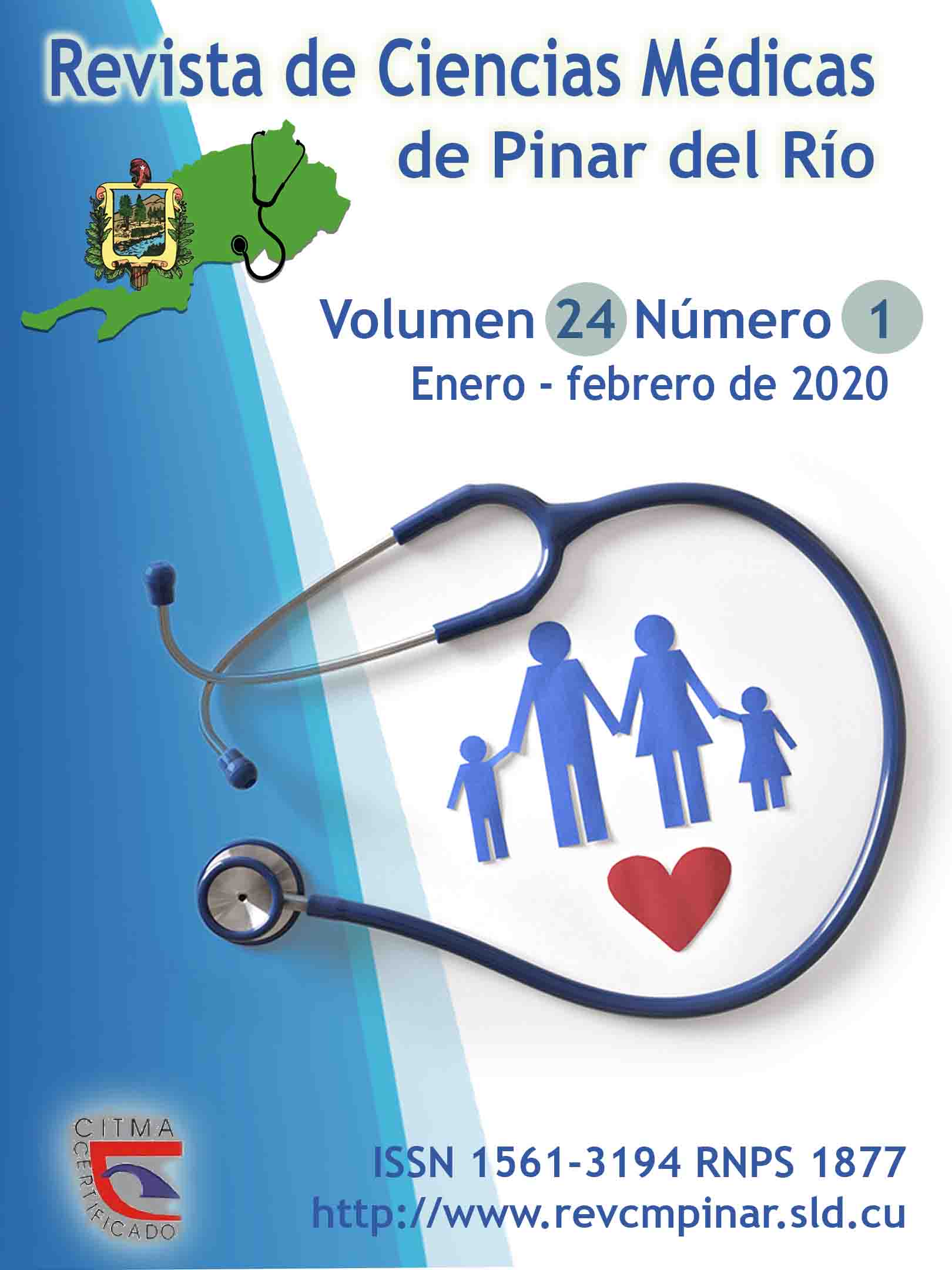Epidemiological factors associated with strokes in San Juan y Martinez municipality
Keywords:
STROKE, CHRONIC DISEASE, LIFE STYLE, RISK FACTORS, SMOKERS, AGE GROUPS, HABITS, HYPERTENSION.Abstract
Introduction: silent stroke can occur or be clinically expressed as an acute event of neurological deficit with permanent sequelae.
Objective: to characterize the epidemiological factors associated with strokes in San Juan y Martínez municipality during the period of November 2017 to May 2018.
Methods: an observational, descriptive and cross-sectional study was conducted. The target group comprised 706 patients diagnosed with cerebrovascular accident in the period studied. The sample consisted of 200 patients who met the inclusion criteria established in the research.
Results: according to age groups and sex, 62 % belonged to male sex and the predominant age was from 70 to 79 years, 43 % of patients were smokers, 55 % had a personal pathological history of strokes, in 97 % of the cases there was an ischemic cerebrovascular accident and among the associated diseases hypertension predominated in 43,1 % of the patients.
Conclusions: stroke prevention is based on the maintenance of healthy habits and lifestyles, the standard of living should be associated with low risk factors, which in turn should be linked to a lower risk of suffering from multiple chronic diseases and may also be favorable in the prevention of strokes, especially those of ischemic types.
Downloads
References
1. Rodriguez Lucci F, Pujol Lereis V, Ameriso Povedano G, Diaz MF, Hlavnicka A, Wainsztein NA, et al. Mortalidad intrahospitlaria por acciente cerebrovascular. Medicina (B. Aires). [Internet] 2013 Ago [citado 15/05/2019]; 73(4): [aprox. 4 p.]. Disponible en: http://www.scielo.org.ar/scielo.php?script=sci_arttext&pid=S0025-76802013000400006
2. Castillo Castillo JL, Oscanoa Espinoza TJ. Dislipidemia como factor de riesgo para enfermedad cerebrovascular: estudio de casos y controles. Horiz. Med. [Internet] 2016 [citado 15/05/2019]; 16(4): [aprox. 6 p.]. Disponible en: http://www.scielo.org.pe/scielo.php?script=sci_arttext&pid=S1727-558X2016000400003
3. Toledo Hernández JM, Toledo Guillan EM, Quesada Leyva L, López Corderí D, Curbelo Toledo M. Comportamiento de los factores de riesgo modificables después del primer evento agudo de la enfermedad cerebro-vascular. AMC [Internet]. 2016 [citado 15/05/2019]; 20(5): [aprox. 10 p.]. Disponible en: http://scielo.sld.cu/scielo.php?script=sci_abstract&pid=S1025-02552016000500008&lng=es&nrm=iso
4. Popuche Piscoya DR, Santana Bazalar DA, Rocha Alvarado C, Peña Sánchez ER, Malca Tello N. Nivel de ácido úrico sérico y recuperación neurológica cuantificada con la escala de NIHSS en pacientes con enfermedad cerebrovascular isquémica en un hospital de Lambayeque 2016. Rev Mexicana Neurociencia [Internet]. 2017 Abr [Citado 15/05/2019]; 18(2): [aprox. 12 p.]. Disponible en: https://www.medigraphic.com/cgi-bin/new/resumen.cgi?IDARTICULO=74257
5. Torres Zafra J, Fonnegra Caballero A, Vicini Parra J. Terapia endovascular en el tratamiento del ACV isquémico agudo: perspectiva en Colombia. Acta Neurol Colomb. [Internet]. 2015 [citado 15/05/2019]; 31(3): [aprox. 6 p.]. Disponible en: http://www.scielo.org.co/pdf/anco/v31n3/v31n3a16.pdf
6. Menéndez Veitía A, Arencibia Núñez A, Chaviano de León M, Svarch E, Matamoros CS, González Otero A, et al. Ultrasonido doppler transcraneal en la prevención del accidente vascular encefálico en niños con drepanocitosis. Rev Cubana Hematol Inmunol Hemoter [Internet] 2015 [citado 22/02/2019]; 31(4): [aprox. 12 p.]. Disponible en: http://scielo.sld.cu/scielo.php?script=sci_arttext&pid=S0864-02892015000400008
7. Castellanos-Ruiz J, Pinzón-Bernal M, Morera-Salazar DA, Eljadue-Mejía JP. Terapia en espejo para el tratamiento de la mano espástica del adulto con hemiplejía: revisión sistemática. Rev Mexicana de Neurociencia [Internet] 2017 Abr [citado 22/02/2019]; 18(2): [aprox. 9 p.]. Disponible en: https://www.medigraphic.com/cgi-bin/new/resumen.cgi?IDARTICULO=74272
8. Sacre González MR, Velázquez Valdés MA, Castillo Ordaz M, Pastrana Trujillo L, Trujillo Morejón N. Caracterización de los cuidadores de adultos mayores hemipléjicos a causa de enfermedad cerebrovascular. MEDISAN [Internet] 2017 [citado 22/02/2019]; 21(8): [aprox. 7 p.]. Disponible en: http://scielo.sld.cu/scielo.php?script=sci_arttext&pid=S1029-30192017000800004
9. Salgado Castillo I, Triana Mantilla ME, Rodríguez Villalonga LE, Arpajón Peña, Hernández Seara A. Características de la enfermedad cerebrovascular extracraneal en el municipio de arroyo naranjo. Rev Cubana Angiol Cir Vasc [Internet] 2017 Dic [citado 22/02/2019]; 18(2): [Aprox. 16 p.]. Disponible en: http://scielo.sld.cu/scielo.php?script=sci_arttext&pid=S1682-00372017000200002
10. Centro de Información Cardiovascular. Factores de riesgo cerebrovascular. [Internet]. Texas Heart Institute; 2016 [citado 25/03/2019]. Disponible en: https://www.ohsu.edu/xd/health/services/heart-vascular/about/
11. Valhuerdi Cerero AJ, Llibre Guerra JJ, Valhuerdi Porto C, Porto Alvarez RB, Muñoz Rodríguez R, Muñoz Rodríguez M. Disfunción cerebral focal vascular en adultos mayores de la comunidad. Prevalencia, factores de riesgo aterogénico y manejo. Rev. Med. Electrón. [Internet] 2015 Oct [citado 22/02/2019]; 37(5): [aprox. 15 p.]. Disponible en: http://scielo.sld.cu/scielo.php?script=sci_arttext&pid=S1684-18242015000500005
12. Escobar Alfonso V, Zaldivar Garit M, Rodríguez de la Rosa G, Cabrera Cordovés JC. Factores de riesgos prevalentes en pacientes ingresados por enfermedad cerebrovascular. Rev Cub Med Mil. [Internet] 2014 Dic [citado 22/02/2019]; 43(4): [aprox. 8 p.]. Disponible en: http://scielo.sld.cu/scielo.php?script=sci_arttext&pid=S0138-65572014000400003
Downloads
Published
How to Cite
Issue
Section
License
Authors who have publications with this journal agree to the following terms: Authors will retain their copyrights and grant the journal the right of first publication of their work, which will be publication of their work, which will be simultaneously subject to the Creative Commons Attribution License (CC-BY-NC 4.0) that allows third parties to share the work as long as its author and first publication in this journal are indicated.
Authors may adopt other non-exclusive license agreements for distribution of the published version of the work (e.g.: deposit it in an institutional telematic archive or publish it in a volume). Likewise, and according to the recommendations of the Medical Sciences Editorial (ECIMED), authors must declare in each article their contribution according to the CRediT taxonomy (contributor roles). This taxonomy includes 14 roles, which can be used to represent the tasks typically performed by contributors in scientific academic production. It should be consulted in monograph) whenever initial publication in this journal is indicated. Authors are allowed and encouraged to disseminate their work through the Internet (e.g., in institutional telematic archives or on their web page) before and during the submission process, which may produce interesting exchanges and increase citations of the published work. (See The effect of open access). https://casrai.org/credit/



